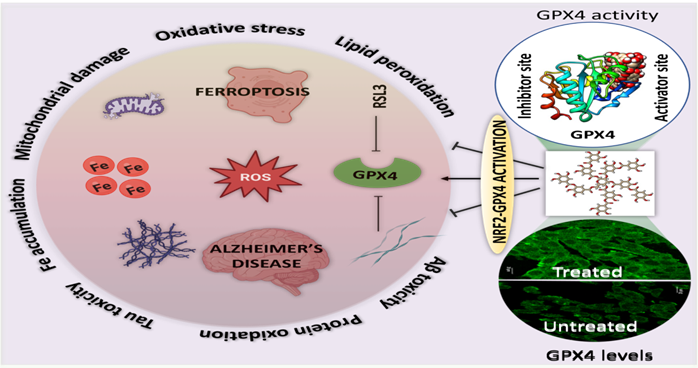New Delhi, 13 SEP 2023 – In a groundbreaking development, scientists have uncovered a potential treatment route for Alzheimer’s disease (AD) using naturally occurring plant-based polyphenols (PPs), such as tannic acid found in trees like Chestnut and Oak. This discovery offers a safe, cost-effective strategy for combatting AD, which has long been a poorly understood and debilitating neurodegenerative disorder.
Alzheimer’s disease is characterized by progressive neurodegeneration, resulting in memory and cognitive decline. Despite extensive research, there is currently no cure for this devastating condition. Recent studies have shed light on ferroptosis, an iron-dependent form of programmed cell death, as a significant contributor to the development of AD. Several key features of AD, including abnormal iron accumulation, lipid peroxidation, reactive oxygen species (ROS), and reduced activity of the antioxidant enzyme glutathione peroxidase 4 (GPX4), align with the characteristics of ferroptosis.
GPX4, a master regulator in the prevention of ferroptosis, plays a crucial role in reducing toxic lipid peroxides produced by the iron-catalyzed reaction of polyunsaturated fatty acids (PUFAs) with ROS. However, the GPX4 pathway is an energetically demanding and low-efficiency process, prompting researchers to explore molecules that can activate and elevate GPX4 levels to combat oxidative stress associated with chronic disorders.
Scientists from the Jawaharlal Nehru Centre for Advanced Scientific Research (JNCASR), an autonomous institute of the Department of Science and Technology (DST), have presented naturally occurring polyphenols (PPs) as innovative and multimodal therapeutic agents capable of ameliorating ferroptosis and AD. Their research has unveiled the potential of tannic acid (TA), a natural polyphenol, to act as both an activator and enhancer of GPX4.
The study reveals that TA inhibits the aggregation of amyloid and tau proteins, reduces oxidative stress, restores mitochondrial function, and inhibits ferroptosis. This novel approach offers an advanced and comprehensive strategy for addressing AD by modulating the GPX4-ferroptosis-AD axis. Notably, TA can elevate GPX4 levels even in the presence of AD pathological conditions, opening exciting new avenues for targeting novel pathways in the etiology of AD and addressing the complex interplay between ferroptosis and AD.
The study, published in the journal Chemical Sciences, represents a significant leap in drug development. The discovery of TA as a ferroptosis inhibitor with the ability to activate and enhance GPX4 introduces a holistic strategy against AD, establishing a mechanistic link between AD and ferroptosis.
By targeting both AD and ferroptosis simultaneously, the research team screened a library of natural polyphenols, ultimately identifying tannic acid as a multifunctional molecule with outstanding potential for mitigating various pathways associated with AD and ferroptosis. This discovery paves the way for synergistic inhibition of ferroptosis in AD and offers new hope for patients suffering from this devastating neurodegenerative disease.
In conclusion, the groundbreaking discovery of tannic acid’s role as a GPX4 activator and ferroptosis inhibitor holds immense promise in the fight against Alzheimer’s disease. This research not only addresses the specific challenges of AD but also contributes to our understanding of neurological disorders, global health, and the well-being of dementia patients. It inspires researchers to explore this alternative axis for therapeutic avenues in the field of neurodegenerative diseases.
Publication Link: Read the full study
Key Facts
🧠 Scientists have discovered a potential treatment for Alzheimer’s disease using natural polyphenols.
🌿 These polyphenols, like tannic acid found in Chestnut and Oak tree twigs, can target the ferroptosis-AD axis.
💡 Alzheimer’s disease is a progressive neurodegenerative disorder with no known cure.
🔬 Ferroptosis, an iron-dependent cell death process, contributes to Alzheimer’s development.
👩🔬 The study by scientists at JNCASR highlights the role of polyphenols in ameliorating ferroptosis and Alzheimer’s.
🔗 Tannic acid was identified as a multifunctional molecule that activates and enhances GPX4, a key enzyme in ferroptosis.
🔬 This discovery opens new avenues for drug development and sheds light on the link between Alzheimer’s and ferroptosis.
Summary:
Natural polyphenols, such as tannic acid, offer a promising strategy to combat Alzheimer’s disease by modulating the GPX4-ferroptosis-AD axis, potentially providing new insights into the disease and drug development.
Frequently Asked Questions
- What is ferroptosis, and how does it relate to Alzheimer’s disease (AD)? Ferroptosis is an iron-dependent form of programmed cell death that has been linked to the development of AD. It involves the accumulation of iron, lipid peroxidation, and oxidative stress, all of which are characteristic features of AD.
- How does tannic acid (TA) work in combating AD? Tannic acid acts as both an activator and enhancer of GPX4, a crucial enzyme in preventing ferroptosis. TA inhibits protein aggregation, reduces oxidative stress, restores mitochondrial function, and inhibits ferroptosis, offering a multifaceted approach to AD treatment.
- What makes this discovery significant for drug development? The discovery of TA as a ferroptosis inhibitor opens up new possibilities for drug development. It presents a holistic strategy for addressing AD and establishes a mechanistic link between AD and ferroptosis, which was previously elusive.
- What are the potential implications of this research for patients with Alzheimer’s disease? This research offers hope for AD patients by providing a novel avenue for treatment. By targeting ferroptosis and AD simultaneously, it may lead to more effective therapies and improved quality of life for those affected by this neurodegenerative disease.
- What are the next steps in further exploring this treatment route? Further research is needed to validate the effectiveness of tannic acid and explore its potential side effects. Clinical trials and studies on larger patient populations will be essential to translate these findings into practical treatments for Alzheimer’s disease.
Also Read August 2023 Consumer Price Index (CPI) Report
























